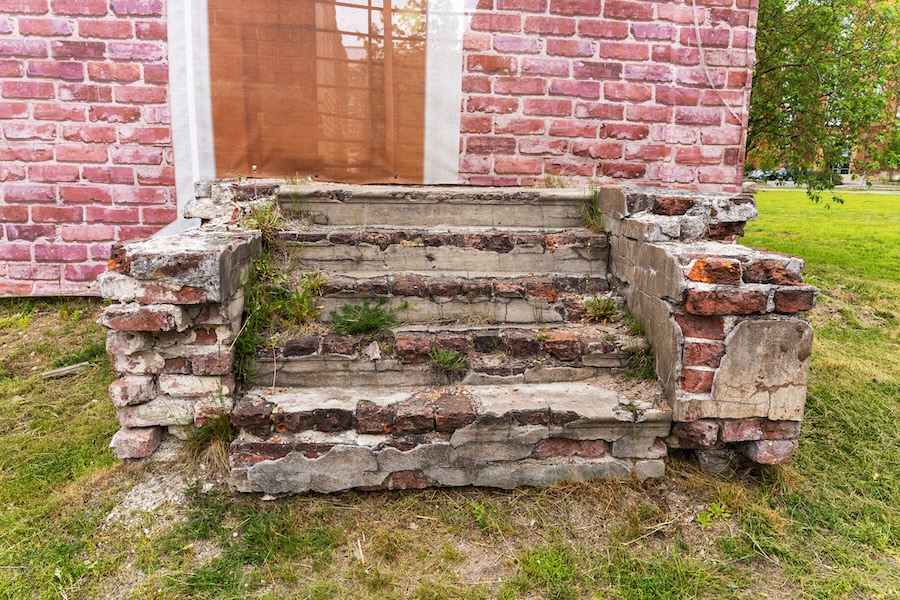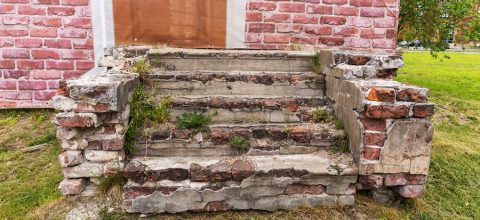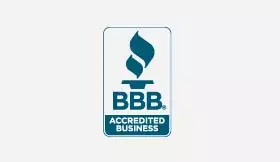The Quick Answer: Repairing a concrete porch involves cleaning the concrete surface, filling cracks with concrete crack filler or concrete patch, applying a bonding agent, and resurfacing with concrete resurfacer or concrete overlay. Small hairline cracks can be fixed with putty knife application, while large cracks may require concrete mix.
Most concrete porch repairs can be completed over a weekend with basic tools and materials. Simple crack repairs might take just a few hours, while extensive resurfacing could require a full day plus curing time. The key is identifying whether your concrete porch damage is surface-level cosmetic issues or deeper structural problems.
Before starting any repair work, assess the extent of damage to your concrete surface. Minor concrete cracks often result from normal settling and weather exposure, especially during winter months. However, if you notice your porch pulling away from your home’s foundation or significant sinking, these issues may require professional evaluation beyond basic concrete porch repair techniques.
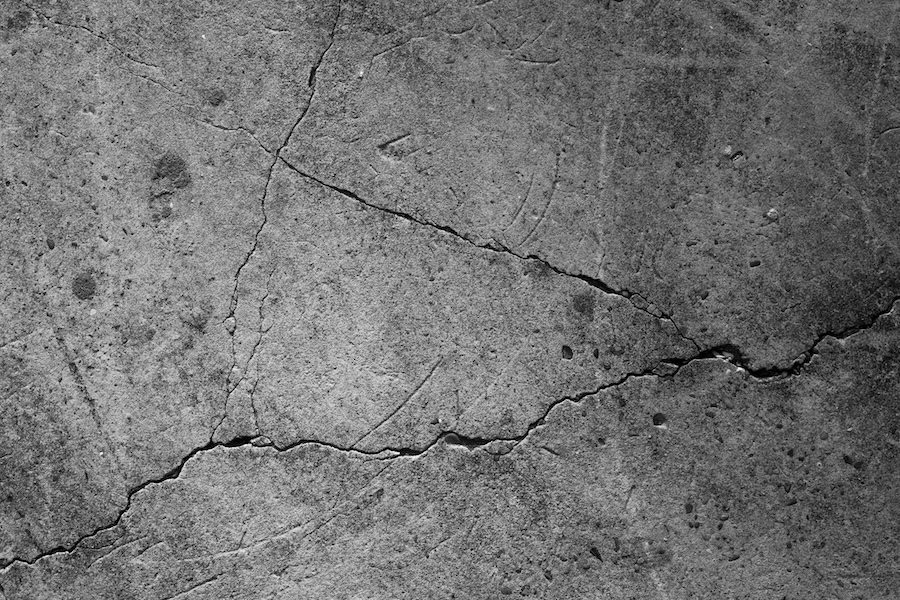
Assessing Your Concrete Porch Damage
Understanding the type and extent of damage to your existing concrete determines the best repair approach. Start by thoroughly examining your concrete slab for different types of cracks and surface deterioration.
Hairline Cracks
These typically appear as thin lines less than 1/16 inch wide. These small cracks often develop naturally as concrete ages and are usually easy to repair with concrete crack filler. Large cracks measuring more than 1/4 inch wide or cracks that show vertical separation indicate more serious issues with your existing porch foundation.
Warning Signs
Look for signs of settling or movement in your concrete porch. If you notice the porch has sunk or tilted away from your home, this suggests underlying soil or foundation problems that may require concrete leveling solutions. In severe cases, structural support issues might need helical pier installation to stabilize the foundation before surface repairs can be effective.
Check the overall condition of your concrete slab during different seasons. Winter months can reveal damage that’s less obvious in warmer weather, as freeze-thaw cycles worsen existing problems. Pay attention to control joints—the intentional grooves cut into concrete to control where cracks form. If cracks appear in unexpected locations rather than along control joints, this may indicate structural movement.
Examine areas where your concrete porch connects to concrete steps or surrounding concrete surfaces. Uneven settling between different concrete sections can create dangerous trip hazards. Document any broken concrete or cracked concrete areas with photos to track whether damage progresses before you begin repairs.
If damage seems extensive or if you notice continued movement after initial repairs, the issue may extend beyond surface-level concrete repair. Further damage could occur if underlying foundation problems aren’t addressed, making it important to distinguish between cosmetic repairs and structural concerns.
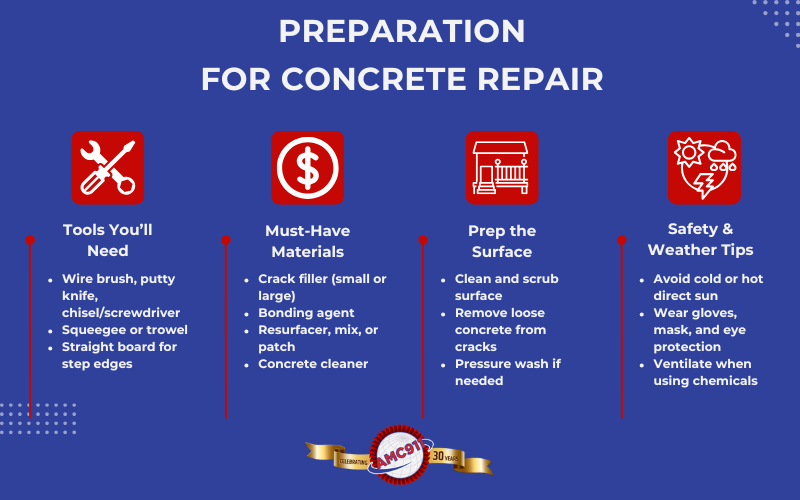
Tools, Materials, and Preparation for Concrete Repair
Successful concrete porch repair starts with proper preparation and having the right tools and materials ready before you begin.
Essential Tools
- Wire brush for cleaning debris and loose concrete
- Putty knife for applying crack filler and small repairs
- Chisel or screwdriver for removing loose concrete from cracks
- Squeegee or trowel for spreading concrete resurfacer
- Straight board for maintaining proper angles on concrete steps
Required Materials
- Concrete crack filler designed for exterior use (small tubes for hairline cracks, larger containers for extensive crack networks)
- Quality bonding agent to ensure new repair materials adhere properly to existing concrete surfaces
- Concrete resurfacer, concrete mix, or concrete patch depending on your specific damage
- Concrete cleaner to remove dirt, oil stains, and loose debris
Surface Preparation Steps
- Begin by thoroughly cleaning your concrete surface with concrete cleaner
- Use a wire brush to scrub away any flaking or deteriorated concrete around damaged areas
- For concrete patio and porch repairs, pressure washing can help reach stubborn stains and prepare bare concrete for new materials
- Remove all loose concrete from crack areas using a chisel or screwdriver
- Ensure clean cracks are free of debris, dust, and standing water before applying any repair products
- For larger repairs involving concrete resurfacer applications, the existing surface must be completely clean and slightly roughened to ensure proper adhesion
Work Area Preparation
- Cover nearby plants and surfaces that might be damaged by concrete cleaner or repair materials
- Have all tools and materials ready before mixing any concrete products
- Proper preparation prevents rushed application that can compromise repair quality
Weather and Safety Considerations
- Check weather conditions before starting work
- Avoid repairs during winter months or when temperatures fall below 50°F, as cold weather prevents proper curing
- Don’t work in direct sunlight on hot days, as rapid drying can cause new concrete to crack
- Gather safety equipment including gloves, eye protection, and dust masks
- Concrete dust can irritate lungs and eyes, especially when using wire brush tools or power equipment
- Ensure adequate ventilation when working with chemical bonding agents or concrete cleaners
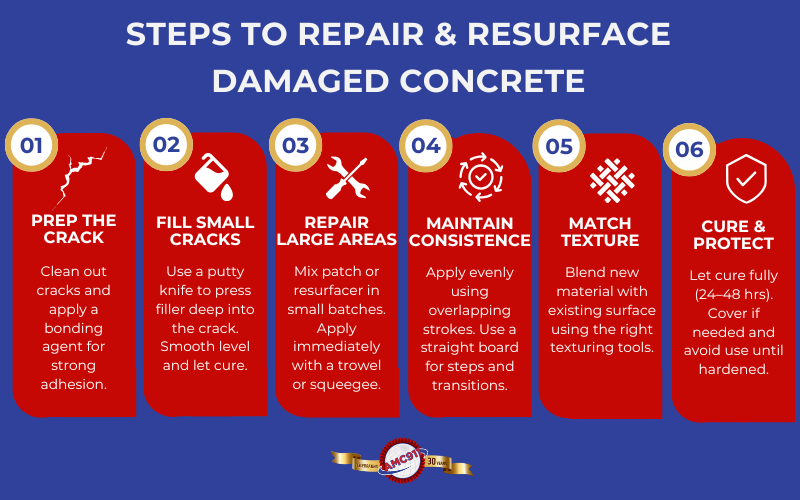
Step-by-Step Concrete Porch Repair Process
Follow these steps to complete your concrete porch repair effectively and safely:
- Start with Small Damage First: Address hairline cracks by applying concrete crack filler using a putty knife, pressing the material deep into the crack. Smooth the surface level with surrounding concrete and allow proper curing time according to manufacturer instructions.
- Prepare Large Cracks for Repair: For cracks requiring more substantial concrete repair, begin by applying bonding agent to clean crack surfaces. This step is critical for ensuring new concrete adheres properly to old concrete.
- Mix and Apply Repair Materials: Mix your concrete patch or concrete mix according to package directions, working in small batches to prevent premature hardening. Apply materials immediately after mixing for best results.
- Handle Extensive Surface Damage: When dealing with widespread deterioration, concrete resurfacer provides an effective solution for rejuvenating worn concrete surfaces. Apply bonding agent to the entire repair area, then spread concrete resurfacer using a squeegee or trowel.
- Maintain Consistent Application: Work systematically across your concrete surface to maintain consistent thickness and avoid visible seam lines. Use steady, overlapping strokes for professional-looking results.
- Address Transition Areas: For repairs involving concrete steps or transitions between different concrete sections, pay special attention to matching existing slopes and textures. Use a straight board to maintain proper angles and prevent creating new trip hazards.
- Texture to Match Existing Surface: The next step involves texturing the repair to match surrounding concrete appearance. Use appropriate tools to replicate the original surface finish.
- Cover Connection Points: Address any areas where your porch connects to concrete patio surfaces or other structures. These transition zones often experience the most stress and require careful attention to prevent future cracking.
- Ensure Complete Coverage: Apply concrete repair materials slightly beyond the visible damage area to ensure complete coverage and prevent edge failures.
- Monitor Curing Process: Monitor your repair work as it cures, especially during the first 24 hours. Cover repairs with plastic sheeting if rain threatens, and avoid walking on repaired areas until fully cured.
- Allow Proper Cure Time: Most concrete repair products require 24-48 hours before normal use, though full strength develops over several days. Be patient during this critical period.
- Work in Sections for Complex Repairs: For complex repairs involving multiple crack patterns or structural concerns, work in sections rather than attempting to fix everything at once. This approach allows you to evaluate the success of each repair phase and adjust techniques as needed.
Remember, quality concrete porch repair focuses on preventing further damage rather than just covering visible problems.
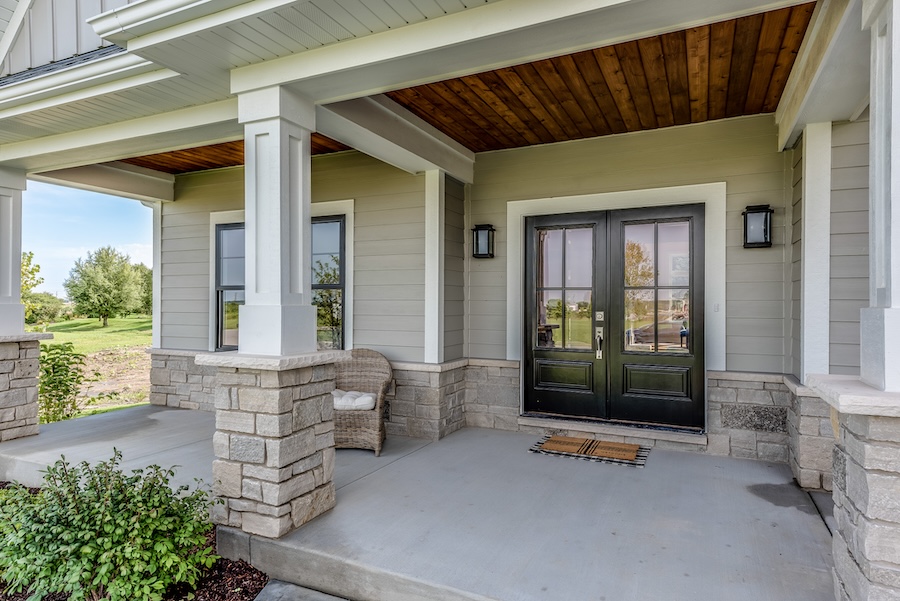
Why Choose AMC911 for Professional Concrete and Foundation Repair
For over 30 years, AMC911 Crawl Space & Foundation Repair has been Hampton Roads’ trusted solution for comprehensive structural repairs. Founded by Brian McClung in the late 1980s, AMC911 offers complete masonry and foundation solutions including foundation leveling, foundation repair, waterproofing, chimney repair, brick restoration, and brick repointing and tuckpointing.
What sets AMC911 apart is our engineering expertise and comprehensive approach. As Class A contractors with an A+ Better Business Bureau rating, our in-house engineering team designs permanent solutions using advanced techniques like helical pier installation for structural support and professional-grade concrete repair solutions.
When your concrete porch problems indicate deeper foundation issues, AMC911’s engineered approach protects your investment while enhancing your home’s curb appeal and value. Contact AMC911 today for a free comprehensive evaluation and discover why Hampton Roads homeowners have trusted us for over three decades.

